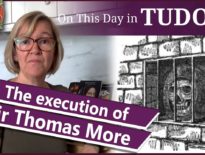On this day in Tudor history, 7th July 1568, naturalist, herbalist, ornithologist, reformer and physician, William Turner, died. Turner is known as “the father of English botany and of ornithology”, but why and who exactly was he?
In today's talk, I give an overview of Turner's life and career, including his attacks on Bishop Gardiner and his time in exile, plus a bit of trivia about the training of his little dog.
Also on this day in Tudor history, 7th July 1556, in the reign of Queen Mary I, Henry Peckham and John Danyell were hanged, drawn and quartered after being found guilty of treason for their involvement in the Dudley Conspiracy. But what was the Dudley Conspiracy? And who was involved in it? What happened? Find out in last year’s video:
Turner’s “A new herball, wherin are conteyned the names of herbes….” - https://archive.org/details/b30342053_0002
Also on this day in history:
- 1537 – Death of Madeleine de Valois, also known as Madeleine of France, first wife of King James V of Scotland. Madeleine died in her husband's arms at Edinburgh just six months after their wedding and less than two months after her arrival in Scotland. She was buried in Holyrood Abbey.
- 1540 – Anthony St Leger was appointed Lord Deputy of Ireland.
- 1545 – Death of William Crane, merchant, musician and Master of the Choristers of the Chapel Royal. He was buried in St Helen's Church, Bishopsgate, before the high altar.
- 1548 – Treaty of Haddington between France and Scotland. By the terms of this treaty, the Scots and French agreed to the marriage of Mary, Queen of Scots, and Francis, the Dauphin.
- 1553 – Goldsmith Robert Reyns informed Mary (future Mary I) of Edward VI's death. Mary was staying with Lady Burgh at Euston Hall, near Thetford, and Reyns had rushed from London to give her the news.
- 1585 – Birth of Thomas Howard, 14th Earl of Arundel, 4th Earl of Surrey, and 1st Earl of Norfolk, politician and art collector, at Finchingfield, Essex. He was the only son of Philip Howard, 13th Earl of Arundel, and his wife, Anne Dacre.
- 1607 – Death of Penelope Rich (née Devereux), Lady Rich, at Westminster. Penelope was the sister of Robert Devereux, 2nd Earl of Essex, and is thought to have inspired poet Philip Sidney's “Astrophel and Stella”. She married Robert Rich, Lord Rich, in 1581, but was having a love affair with Charles Blount, Baron Mountjoy, by 1595. Penelope married Blount, who was now Earl of Devonshire, in a private ceremony in 1605 after her divorce. The marriage led to the couple's banishment from court. Devonshire died in 1606.
Transcript:
On this day in Tudor history, 7th July 1568, naturalist, herbalist, ornithologist, reformer and physician, William Turner, died. Turner is known as “the father of English botany and of ornithology”, but why and who exactly was he?
Here are some William Turner facts…
• William Turner was born in Morpeth, Northumberland, in around 1509/1510, and was the son of a tanner.
• He was educated at Pembroke College, Cambridge, under the patronage of Thomas, Baron Wentworth, and graduated with a Bachelor of Arts before being elected as a fellow in 1531. He began studying for a Masters in 1533 and became the college’s treasurer in 1538.
• Turner was of the reformed faith and was friends with Bishops Hugh Latimer and Nicholas Ridley who ended up being executed as heretics in Mary I’s reign as two of the Oxford Martyrs. He became a deacon in 1536 and began preaching.
• Despite being a deacon, he married Alice Alder in 1540 and in 1541 when his marriage led him to get into trouble, he and his wife fled into exile abroad.
• After travelling up the Rhine, Turner settled for a year or so in Ferrara in Italy and studied for his MD at Bologna. He also studied botany. Then he moved on to Switzerland and finally back to the Rhineland. Turner recorded the plants and birds he saw on his journey.
• In 1543, Turner published “The Huntyng & Fyndyng out of the Romishe Foxe”, which attacked Bishop Stephen Gardiner, and also a tract on birds. In the meantime, he supported his wife, son and daughters with his practice as a physician, before moving into the service of he Duke of Emden for four years. He published another attack on Bishop Gardiner in 1545.
• In 1547, following the death of King Henry VIII, Turner returned to England to serve as physician and chaplain to Edward Seymour, Duke of Somerset and Lord Protector, and as a member of Parliament.
• He published a botanical work, “Names of Herbes” in 1549, and in 1550 was appointed prebendary of Botevant in York Cathedral and then Dean of Wells Cathedral in 1551. In 1551 he also published the first part of his great work “A new herball, wherin are conteyned the names of herbes”.
• In December 1552, he was ordained as a priest by Bishop Ridley, but 1553 saw the accession of the Catholic Queen Mary I and he fled into exile once more, spending time in Cologne, Worms, and Weissenburg. While in exile, he worked on the second part of his herbal, a work on fish, one on medicinal baths, and also another attack on Bishop Gardiner - The Huntyng of the Romyshe Wolfe – and A New Booke of Spirituall Physik.
• Turner returned to England after Mary’s death in 1558 but wasn’t restored as dean at Wells until 1560, although he began preaching earlier.
• The second part of his herbal, which was dedicated to his former patron, Thomas Wentworth, was published in 1562, with the third part following in 1568. The final part was published with revised editions of the first two parts and was dedicated to Queen Elizabeth I.
• In Elizabeth I’s reign, he continued to be a religious controversialist in the Vestments Controversy, with his opposition of what he viewed as papist vestments.
• Turner spent his final years at his London home in Crutched Friars and died there on this day in 1568. He was buried two days later in St Olave’s Church, Hart Street.
• Turner’s other works include “New Boke of the Natures and Properties of All Wines”, “Booke of the Natures and Vertues of Triacles” (or ointments), “Of the natures and properties aswell of the bathes in England as of other bathes in Germany and Italy”, translations of religious works and his own religious works “Examination of the Masse and of that Kind of Priesthood”, and “Agaynst the poyson of Pelagius, lately renued, and styrred up agayn, by the furious secte of the Annabaptists”, as well as those already mentioned.
• And now for some Turner trivia, a fact that I just love, according to his biographer Whitney R D Jones, Turner trained his little dog “to leap up and snatch off the corner-cap of a bishop at table”. Another Turner fact is that Turner created the now recognisable English names for many species which had previously only be known by their Latin names. I’ll give you a link to read Turner’s herbal for yourself.
• In Carlisle Park, in the heart of Turner’s hometown, Morpeth, is the William Turner Garden which features a reconstructed Tudor garden, including a traditional Knot Garden and Physic Beds containing examples of some of the medicinal plants with which William Turner worked.



Leave a Reply